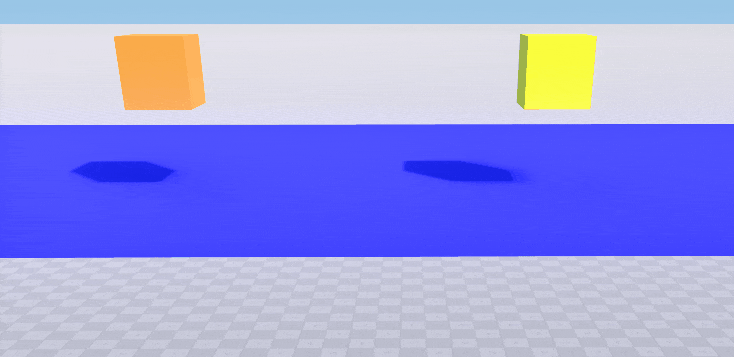Enabling Selective Surface-Based Collision

Surface-based collision using collision masks
This example shows how to enable collision detection for a surface using bitmasks. Two boxes (orange and yellow), each with a body and a box shape assigned, and a blue plane are created. We want the yellow box to collide with the surface of the blue plane and the orange box to pass through. So we set the following collision masks for the shapes of the boxes and for the surface of the plane.
| Element | Mask |
|---|---|
| Yellow box: shape | 0010 |
| Orange box: shape | 0001 |
| Plane: surface | 0010 |
Notice
Surface-to-surface collisions cannot be enabled using collision masks.
In the AppWorldLogic.h file, define smart pointers for the objects of our scene.
Source code (C++)
// AppWorldLogic.h
#include <UnigineObjects.h>
/* .. */
class AppWorldLogic : public Unigine::WorldLogic {
public:
/* .. */
private:
Unigine::ObjectMeshStaticPtr box1;
Unigine::ObjectMeshStaticPtr box2;
Unigine::ObjectMeshStaticPtr plane;
Unigine::PlayerSpectatorPtr player;
};Insert the following code into the AppWorldLogic.cpp file.
Notice
Unchanged methods of the AppWorldLogic class are not listed here, so leave them as they are.
Source code (C++)
#include "AppWorldLogic.h"
#include "UnigineGame.h"
#include "UnigineObjects.h"
/* .. */
using namespace Unigine;
using namespace Math;
/// function, creating a named box of a specified size and color at pos
ObjectMeshStaticPtr create_box(const char *name, const vec4& color, const vec3& size, const vec3& pos)
{
// creating an auxiliary mesh with a box surface
MeshPtr meshbox = Mesh::create();
meshbox->addBoxSurface("box_surface", size);
// creating a static mesh object using an auxiliary mesh and setting parameters
ObjectMeshStaticPtr OM = ObjectMeshStatic::create(meshbox);
OM->setWorldTransform(Mat4(translate(pos)));
OM->setMaterialParameterFloat4("albedo_color", color, 0);
OM->setCollision(1, 0);
OM->setName(name);
// assigning a rigid body with our object
BodyRigid::create(OM);
// creating a box shape and assigning it to the rigid body of our object
OM->getBody()->addShape(ShapeBox::create(size), translate(0.0f, 0.0f, 0.0f));
// clearing the auxiliary mesh
meshbox->clear();
return OM;
}
/// function, creating a named plane having a specified width and height at pos
ObjectMeshStaticPtr create_plane(const char *name, float width, float height, const vec3& pos)
{
// creating an auxiliary mesh with a plane surface
MeshPtr meshplane = Mesh::create();
meshplane->addPlaneSurface("plane_surface", width, height, 1.0f);
// creating a static mesh object using an auxiliary mesh and setting parameters
ObjectMeshStaticPtr OM = ObjectMeshStatic::create(meshplane);
OM->setWorldTransform(Mat4(translate(pos)));
OM->setMaterialParameterFloat4("albedo_color", vec4(0.0f, 0.0f, 1.0f, 1.0f), 0);
OM->setCollision(1, 0);
OM->setName(name);
// clearing the auxiliary mesh
meshplane->clear();
return OM;
}
int AppWorldLogic::init()
{
// setting up a player
player = PlayerSpectator::create();
player->setPosition(Vec3(0.0f, -6.0f, 12.5f));
player->setDirection(vec3(0.0f, 1.0f, -0.4f), vec3(0.0f, 0.0f, -1.0f));
Game::setPlayer(player);
// creating a scene: two boxes and a plane
box1 = create_box("box1", vec4(1.0f, 1.0f, 0.0f, 1.0f), vec3(0.5f), vec3(1.5f, 0.0f, 12.0f));
box2 = create_box("box2", vec4(1.0f, 0.5f, 0.1f, 1.0f), vec3(0.5f), vec3(-1.5f, 0.0f, 12.0f));
plane = create_plane("plane", 10.0f, 6.0f, vec3(0.0f, 1.0f, 10.5f));
// setting shape collision mask for the first box [00000000000000000000000000000010]
box1->getBody()->getShape(0)->setCollisionMask(2);
// setting shape collision mask for the second box [00000000000000000000000000000001]
box2->getBody()->getShape(0)->setCollisionMask(1);
// setting collision mask for the plane surface [00000000000000000000000000000010]
plane->setCollisionMask(2, 0);
return 1;
}
/* .. */The information on this page is valid for UNIGINE 2.19 SDK.
Last update:
2024-08-16
Help improve this article
Was this article helpful?
(or select a word/phrase and press Ctrl+Enter)